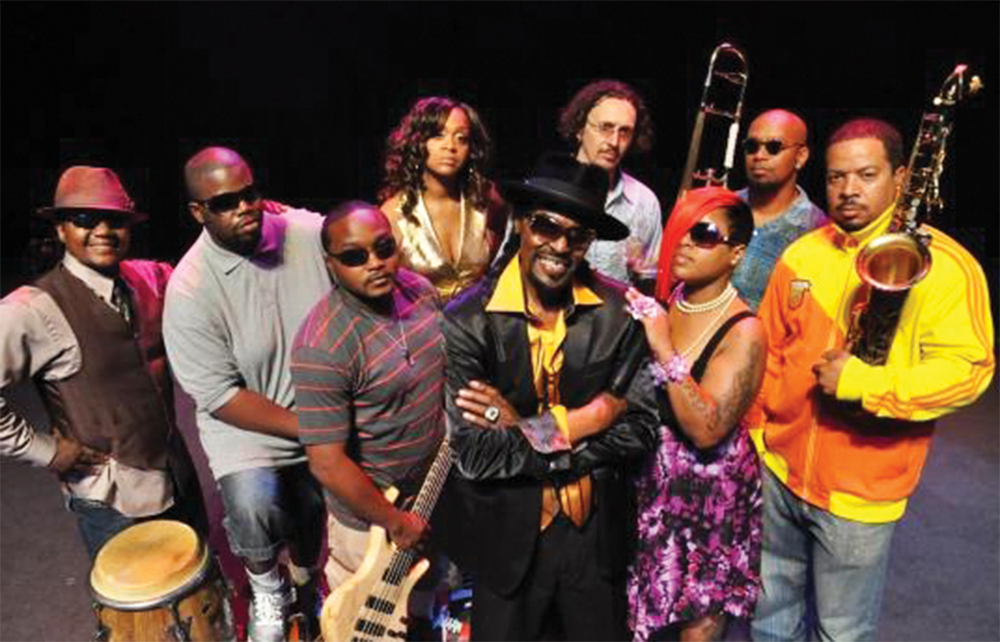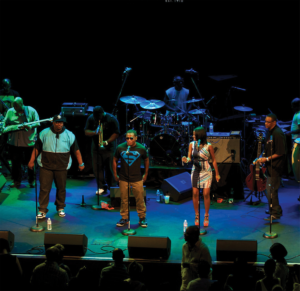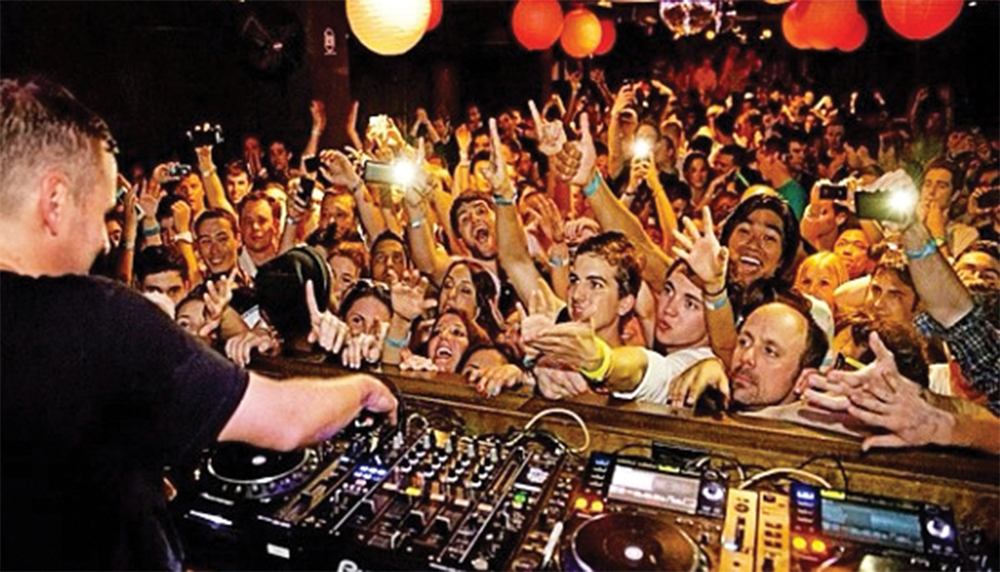
Frenetic drum beats, cheering and chanting pour out onto U Street. The sounds emanate from the insides of theaters, clubs and performance halls, where masses of Washington, D.C. music fans sing and dance, abandoning themselves to the untamed spirit of the “Chocolate City.” Although this scene is timeless, the type of music played today sounds quite different than it did a decade ago as the go-go music native to D.C. has become increasingly replaced by hip-hop.
The District is the birthplace of go-go music, a blend of funk, hip-hop, blues and soul that is rooted in live performance and call-and-response between the artist and audience. While hip-hop rose to popularity across the rest of the country in the 1980s and ’90s, go-go remained the dominant force in the D.C. region. Today, even as D.C. continues to develop its own hip-hop presence, the influence of go-go runs deep.
Origins of Go-Go
Many cities have their own unique sounds that drive musical progression; Nashville, for example, is the home of country music, and Atlanta is the birthplace of trap. In the District, go-go is the signature genre. In the ’80s and ’90s, local legends like Chuck Brown & the Soul Searchers, Black Heat and The Young Senators began creating their own distinctive upbeat sounds.

Chuck Brown & the Soul Searchers began by playing funk music for dancing audiences. Later, Brown had the idea to keep the beat going between songs to keep the crowd moving and the party going. These transition beats became very popular, and thus go-go music was born.
“The essence and energy of go-go music and the live performance is powerful. Once the band hits a certain pocket or bounce … you can watch the entire club and the band rock out together, just like an [electronic dance music] concert,” Charles “Shorty Corleone” Garris of the go-go band Rare Essence said. Rare Essence achieved mainstream success in the ’90s, and later played at one of the inaugural balls in 2009.
Natsu Onoda Power, an associate professor in Georgetown’s Program in Theater and Performance Studies, characterized the go-go scene as having “nonstop energy, call-and-response audience participation, a sense of community and unity, affirmation of identity as a D.C. resident — I scream ‘Northwest! when they call out ‘Where ya from?’”
This frequent audience engagement enhances the already energetic atmosphere and creates an almost peerless ambience. Today, one can still see traditional go-go music live from acts like Rare Essence, Bela Dona and Backyard Band right here in the capital city.
Go-go maintained a dominant position in the Washington music scene from the 1960s to the 2000s. Initially, it arose as an outlet for black communities to let their voices be heard, and ultimately became a unifying force against the dissolution of black culture in the “Chocolate City” during the drug epidemic of the ’80s.
Its influence in this time contributed heavily to the development of black culture in D.C. and remains an important building block of the city today.
“Go-go music and the community that was built among the African-American community was one that was centered around political outcry and voice,” said Myiah Smith (SFS ’20), a Georgetown student and daughter of David Smith, an ’80s go-go artist. “This was during a time where they were being ignored, they weren’t being acknowledged, the issues that they faced in their communities were turned a cold shoulder. And so go-go music was the push against that … it’s about strength and happiness and pride.”
Go-go music was so popular for years that it precluded the emergence of hip-hop in the District. Over time, however, the genres began to intertwine and hip-hop artists used go-go as a source of inspiration and a springboard for local and national attention.
Origins of D.C. Hip-Hop
While the lively sounds of go-go reverberated through D.C., another phenomenon was taking the rest of the country by storm: hip-hop. In the 1980s and ’90s, hip-hop rapidly grew in prominence, and urban regions with dense black populations such as New York City and Los Angeles developed their own hip-hop subcultures.
Despite its rich black heritage, D.C. never came close to reaching the hip-hop prominence of other cities and was largely overshadowed. DJ Heat, a local radio DJ, explained the ’90s Washington hip-hop void in an interview with public radio station WAMU in 2015: “It was all about banging on go-go beats on your desk and in the lunch room … no one cared about hip-hop.”
Though go-go continued to dominate, the D.C. hip-hop community soon caught its first big break with the rise of its first major rap star, Wale. Drawing from his District roots, Wale gained regional attention with his agile flow over cleverly sampled go-go on the 2006 single “Dig Dug (Shake It).”

“As far as today’s hip-hop, we have to give credit to Wale. He’s the ambassador of that sound, mixing go-go beats with rap and taking it mainstream,” Garris, better known by his stage name Shorty, said.
Wale’s celebrity continued to grow following the release of several well-received mixtapes as well as his $1.3 million deal with Interscope Records.
The recent explosion of D.C. hip-hop is not limited to Wale. The scene has grown immensely over the past 10 years, with artists drawing inspiration from a variety of regions and styles.
Unlike cities such as LA or Houston, the District does not have a distinctive regional sound. But this allows for local artists to experiment without being tied down to one particular style. Local rapper GoldLink, for example, infuses his songs with an electronic bounce. GoldLink is perhaps Washington’s most promising rising star: his rolling, half-sung verses and hooks over innovative production have attracted the attention of music critics and fans.
What could explain the massive growth of D.C. hip-hop over the past decade?
The careers of rappers like Wale, GoldLink and Maryland native Logic may hold the answer. Before any major radio singles, each first amassed a significant internet following through mixtapes released online. These, in turn, attracted the attention of blogs, music reviewers and, finally, record labels. These rappers came to prominence through the support of their diverse online fan bases, rather than organically through the local hip-hop scene. By connecting D.C. rappers with audiences outside of D.C.’s loyal go-go community, the growth of the internet has allowed District hip-hop to truly flourish.
From Go-Go to GoldLink
When it originated, go-go music was more closely associated with funk than hip-hop, but over time, hip-hop has influenced the genre and blurred the boundaries between them. Go-go pioneers like Shorty have even accepted the new sound.
“[It] represents the same elements — one big party,” Shorty said.
However, as a result, go-go music has been pushed out to the outskirts of D.C. Its influence remains prominent in the sounds of new artists in these area, as well as in hip-hop artists on a broader scale.
In Washington, the go-go community also serves as a platform for rappers to grow and gain a following while still being a rich source of history and inspiration with great stories to share with the world.
As Shorty puts it: “D.C. hip-hop acts get the best of both worlds being in a go-go city.”
However, the existence of pure go-go music has been, and continues to be, threatened by gentrification.
“One of the big issues as a Washingtonian going to Georgetown that I see is sort of the death of Chocolate City. … Now go-go is predominantly in Maryland, on the outskirts of D.C.” Smith said. “The solution would be communities making an effort to uplift other people’s cultures … preserving local culture, making venues and outlets so that go-go professionals and go-go bands are able to perform, and then even having fairs for D.C. music and D.C. cultures.”
In Washington, go-go and hip-hop culture remain tightly intertwined. Ultimately, they build off one another, both contributing to the District’s rich musical culture.
The same themes of celebration, empowerment and solidarity in the face of social and political injustice are shared between them. Despite gentrification, go-go is still alive and well in the hearts and ears of those who appreciate its cultural significance.
Its legacy continues through bands like Rare Essence, who are still playing after more than 30 years. It lives on through passionate, loyal fan bases who remember the vibrant beats of the “Chocolate City.” With its themes of celebration and pride, empowerment and strength within the black community and outcry against social and political injustice, go-go is more needed than ever.



















